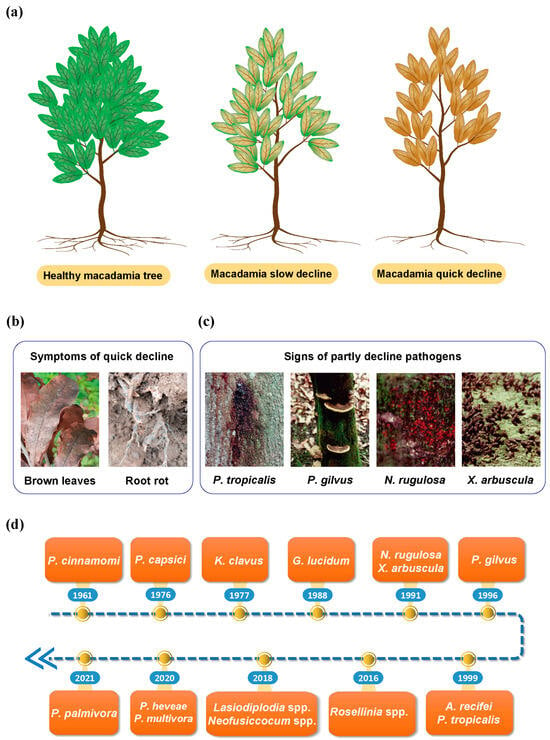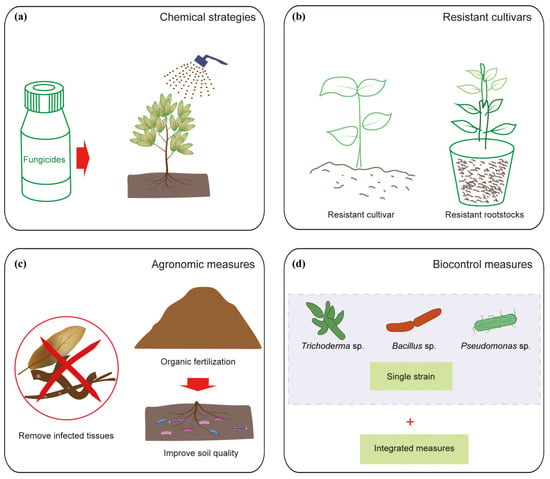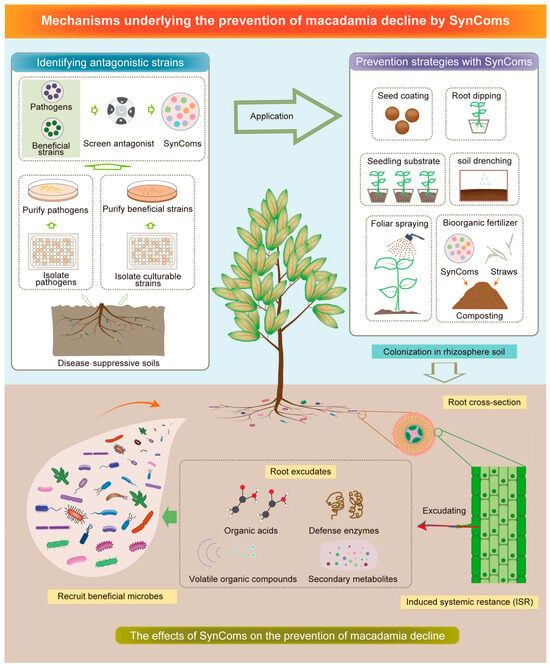Your browser does not fully support modern features. Please upgrade for a smoother experience.
Please note this is an old version of this entry, which may differ significantly from the current revision.
Subjects:
Agronomy
Macadamia decline poses a serious economic threat to the macadamia industry. It exhibits either a slow decline due to infection by Kretzschmaria clavus or Ganoderma lucidum, or a quick decline caused by pathogens like Phytophthora spp., Lasiodiplodia spp., Neofusiccocum spp., Nectria rugulosa, Xylaria arbuscula, Phellinus gilvus, Acremonium recifei, and Rosellinia spp. Chemical strategies, resistant cultivars, and agronomic measures have been widely adopted to control macadamia decline, but effective biological control measures have rarely been applied.
- macadamia decline
- disease
- biological control
- Synthetic microbial communities
1. Introduction
Macadamia (Macadamia integrifolia Maiden and Betche) is a valuable nut tree species native to the coastal areas of northern New South Wales and southern Queensland in Australia, with a wide climatic adaptability [1]. Macadamia nuts are famous for their high nutritional value and healthcare benefits by containing abundant unsaturated fatty acids (e.g., oleic acid, arachidonic acid, and palmitoleic acid), protein, amino acids, and various vitamins (e.g., vitamin B1, B2, and nicotinic acid) [2].
However, the escalating cultivation of macadamia is accompanied by the risk of various diseases, particularly macadamia decline. Macadamia decline was first observed on the east of Hawaii Island [5], but has become a major challenge to macadamia production in the major regions such as Queensland, China, South Africa, and Kenya [6]. This disease includes slow decline and quick decline, with the latter being more prevalent. Macadamia decline is caused by multiple pathogens [7,8], leading to several symptoms, including root rot, leaf blackening, branch wilt, and seedling damping-off [8], so it represents a significant threat to macadamia production and profitability.
Despite many years of efforts in suppressing pathogens through the use of agrochemicals, resistant cultivars, and agronomic measures, the prevention and control of macadamia decline are still large challenges. For instance, while Fosphite® application can alleviate symptoms of macadamia decline, it only extends the productive life of macadamia trees by approximately 700 days [11]. The cultivation of disease-resistant cultivars is both expensive and time-consuming [12], and agronomic measures cannot entirely prevent disease occurrence [13].
The microbiome plays a key role in plant health and disease [14]. The utilization of beneficial biological control microbes presents a promising alternative to combat soil-borne diseases [15,16]. Numerous biological control agents, including Bacillus, Pseudomonas, Trichoderma, Streptomyces, Flavobacteria, Enterobacter, Actinomycetes, Serratia, Alcaligenes, and Klebsiella strains, function as disease antagonists, rhizosphere colonizers, and plant growth promoters [17,18]. Many of these have been commercially exploited for the control of plant diseases [19]. Synthetic microbial communities (SynComs) have demonstrated greater efficacy than single strains in long-term colonization and functionality within the rhizosphere soil [20,21]. These SynComs can provide antibiotics, secondary metabolites, enzymes, and other compounds with pathogen inhibitory effects [22].
2. Macadamia Decline
2.1. Symptoms and Pathogens
Macadamia trees face two distinct forms of decline diseases, i.e., slow decline and quick decline. The slow decline, caused by Kretzschmaria clavus [5] or Ganoderma lucidum [24] is characterized by a progressive onset of symptoms such as leaf discoloration, leaf drop, and branch dieback. These two pathogens induce slightly different symptoms, with K. clavus producing small, mushroom-shaped lesions on the roots and basal trunks of the infected trees, marked by obvious black lines [5], but G. lucidum producing large brown basidiocarps on the lower trunk or above decaying roots [8].
The quick decline is more detrimental to macadamia trees [25], often resulting in swift tree death within a month with the canopy turning to dry brown (Figure 1a,b). This type of decline is caused by various pathogens (Figure 1d), including Phytophthora spp. (e.g., P. tropicalis, P. capsici, P. cinnamomi, P. heveae, P. palmivora, P. multivora) [10,26,27,28,29,30], Nectria rugulosa [31], Xylaria arbuscula [25], Phellinus gilvus [32], Acremonium recifei [29], and Rosellinia spp. [33]. Among these pathogens, Phytophthora is not only responsible for macadamia decline [10], but also causes diseases in other perennial tree crops like avocado, chestnut, apple, plum, mango, and pistachio [18,34]. Although P. tropicalis, P. cinnamomi, P. gilvus, and P. heveae belong to the Phytophthora spp., they exhibit slightly distinct symptoms of decline disease. For instance, both P. cinnamomi and P. tropicalis can induce gum exudation in the infected macadamia trees (Figure 1c) [35]. P. gilvus generates large, dark yellowish-brown basidiocarps on the trunks of infected trees (Figure 1c) [32], a characteristic unlike those produced by other fungal pathogens. N. rugulosa produces small, reddish perithecia on the trunks, accompanied by symptoms of drying bark and grayish wood [25].

Figure 1. Symptoms and pathogens of macadamia decline disease: (a) Diagram of slow decline and quick decline. (b) Typical brown leaves and roots of quick decline. (c) Infected sites and their characteristics of quick decline. (d) Timeline of the major decline pathogen studies over the past half-century.


2.2. Pathogenesis
2.2.1. Infection Sources
Investigations conducted in the forests adjacent to macadamia orchards in Hawaii first revealed the presence of fruiting bodies of K. clavus on both dead and diseased trunks of melochia and trumpet trees (Figure 2) [37]. Isolates of K. clavus, sourced from these diseased trees within these forests, had the ability to infect macadamia trees [37], suggesting that they could be a significant source of infection for macadamia. Other recognized sources of infection include sporangia and zoospores of P. tropicalis, basidiospores of P. gilvus, stromata of K. clavus, ascospores, marconidia and microconidia of N. rugulosa and X. arbuscula, as well as conidia of A. recifei [5,38,39].

Figure 2. Bottom-up infection caused by macadamia decline pathogens. (a) Infection by the original pathogens: pathogens are derived from nearby forest plants or soil-borne pathogen carriers, including diseased branches, leaves, and roots. Some pathogens infiltrate into plants via root system, leading to an outbreak of pathogens in the rhizosphere soil. (b) Internal damage to macadamia by pathogens: pathological tissues carrying some pathogens infect neighboring macadamia trees, causing root damage. Additionally, stems and leaves become infested, resulting in plant disease or death. (c) Environmental factors accelerate decline progression: high temperatures can accelerate the spread of pathogenic spores. Rainwater can carry plant remnants carrying pathogenic spores to new orchards and cause new decline outbreak. Another way by which the decline disease can be spread is though insects such as beetles.
2.2.2. Internal Damage
Macadamia trees have substantial resilience and can sustain growth to some degree in the absence of conspicuous aboveground symptoms. This resilience is primarily due to several factors. First, the high crystallinity of cellulose in the plant can provide a certain physical barrier to prevent the rapid invasion of pathogens. Second, the high C/N ratios of tree biomass may inhibit the proliferation of pathogens in the heartwood of trees [40]. Despite these natural defenses, the pathogens can still infect macadamia trees, since their roots are short and most proteiod roots are close to the soil surface [43]. This kind of root system is susceptible to infection by pathogens such as X. arbuscula, resulting in approximately 10% of roots becoming rotted after a period of five years [5]. The root system is pivotal in coordinating the tree’s response to various stresses, including preventing pathogen attacks [44]. Therefore, damage to the root system by pathogens would facilitate pathogen proliferation within the tree and potentially impair the functions of xylem and cambium tissues.
2.2.3. External Factors
Environmental factors can significantly influence the emergence and spread of macadamia decline. Temperature is a crucial factor, as it affects the growth and sporulation of pathogens. High temperatures, particularly those exceeding 30 °C, can cause a rapid surge in the number of sporangia of pathogens like P. cinnamomi [46,47] (Figure 2). The isolates of Phytophthora have an optimal growth temperature of 34 °C, which is higher than the mean annual temperature in tropical regions [48]. Rainfall plays a significant role in the spread of decline disease (Figure 2). Fruiting bodies, often transported by rainwater from infected trees to the soils around other trees, remain in the rhizosphere until conditions are favorable for their subsequent outbreak [49].
4. Control Strategies of Macadamia Decline
The control strategies of macadamia decline can be categorized into chemical intervention, the use of resistant cultivars, agronomic measures, and biological control measures (Figure 4). Nevertheless, integrated control strategies that utilize two or more of these measures are becoming more and more popular.

Figure 4. Control strategies of macadamia decline: (a) chemical strategies, (b) resistant cultivars, (c) agronomic measure, and (d) biocontrol measure.
4.1. Chemical Strategies
Fungicides are extensively utilized to control the pathogens of macadamia decline [54], with a particular focus on Phytophthora species (Figure 4a). Different fungicides have been registered and used worldwide, such as carboxylic acid amide fungicides (dimethomorph, flumorph, pyrimorph, and mandipropamid) and benzamide fungicides (fluopicolide and propamocarb) [55].
4.2. Resistant Cultivars
Plant breeding strategies, aiming to enhance belowground traits that positively influence the rhizosphere microbiome, present a promising avenue for sustainable crop production [60]. The severity of macadamia decline may be partly attributed to genetic factors [27]. Although identifying and utilizing disease-resistant cultivars are challenging, it is rewarding [61]. In addition to breeding selection focusing on yield enhancement, breeding more tolerant macadamia cultivars could reduce the incidence and severity of decline disease (Figure 4b) [11].
4.3. Agronomic Measures
Good orchard hygiene helps reduce the spread of decline disease by minimizing pathogen infection (Figure 4c). Several key practices are recommended for pathogen suppression, including the removal of dead or dying limbs from the crown, the modification of canopy coverage in accordance with the severity of macadamia decline symptoms, and the installation of shade nets [68].
4.4. Biological Control Measures
Biological control strategies, utilizing microbial antagonists (bacteria and fungi) [17] or beneficial insects [75], has received tremendous attention as a safe and potentially efficacious approach against soil-borne pathogens (Figure 4d). Certain beneficial microbes, e.g., Trichoderma spp., have been shown to enhance the resistance of macadamia to decline diseases. For example, T. hamatum was employed as a biocontrol agent to shield macadamia from infection by Lasiodiplodia theobromae, a pathogen responsible for kernel rot, branch dieback, and macadamia decline [7]. The application of a T. hamatum conidial suspension significantly reduced the size of lesions caused by L. theobromae on macadamia leaves [76].
4.5. Control with Multiple Measures
Besides the implementation of individual control measures, there is an escalating focus on the simultaneous use of multiple strategies for mitigating macadamia decline. In China, a combination of Trichoderma harzianum, humic acid, and urea was found to be effective in preventing and controlling macadamia decline [68]. The management procedure includes the removal of dry branches and leaves based on the severity of decline symptoms, the installation of shade nets, and the irrigation of roots with a recovery solution. For long-term control, late topdressing was implemented by applying 5 kg of organic fertilizer per plant in ring channels 60–80 cm around the stem.

5. Macadamia Decline Prevention: SynComs Application via Multiple Approaches
5.1. Identification of Antagonistic Microbes and Construction of SynComs
The primary objective is to identify the beneficial microbes with antagonistic effects on decline pathogens (Figure 5). The disease-suppressive soils present an optimal resource for screening and isolating potential biological control agents [80]. Core microbiomes, composed of antagonistic microbes, are instrumental in inhibiting disease incidence and fostering plant growth [84].

Figure 5. Biocontrol application in mitigating macadamia decline: The initial step involves the isolation, screening, and identification of decline pathogens and antagonists. The subsequent step entails the construction of SynComs and their integration with various strategies such as seed coating, root dipping, seedling substrates, soil drenching, foliar spraying, and bio-organic fertilizer application to augment the colonization of SynComs in the rhizosphere soil. Ultimately, SynComs can serve as an alternative to plant protection by inducing systemic resistance and facilitating the release of root secretions including organic acids, defense enzymes, volatile organic compounds, and secondary metabolites. SynComs: Synthetic microbial communities.
5.2. Macadamia Decline Prevention Strategies Using SynComs
Several studies have demonstrated that the effectiveness of biological control can be influenced by different inoculation methods [86,87]. To improve the survival rate of SynComs and enhance the management of macadamia decline, a combination of SynComs with various strategies is recommended, including seed coating, root dipping, seedling substrates, soil drenching, foliar spraying, and bio-organic fertilizer application (Figure 5).
5.3. Mechanisms Underlying the Inhibitory Effects of SynComs on Macadamia Decline
The assembly of plant-associated rhizosphere microbiomes is highly complex due to their inherent heterogeneity [105]. Advanced multi-omics technologies, including metagenomics, transcriptomics, proteomics, and metabolomics, have been utilized to elucidate the function of the microbiome in the rhizosphere [106,107,108], and to explore plant–microbe and microbe–microbe interactions under SynComs inoculation. A comprehensive understanding of the synthetic microbiome’s genome characteristics through metagenomics can pinpoint the antagonistic genes against specific pathogens [109]. Transcriptomics serves as the most effective method for unveiling alterations in gene expression when plants interact with SynComs [110], thereby identifying the genes of plants responding to SynComs and inferring the metabolic pathways and biological processes involved. A proteomics approach allows for the identification of proteins associated with the biocontrol processes and differential expression [110]. Metabolomic analyses have the potential to reveal perturbations in signaling or output pathways that significantly influence the outcome of a plant–microbe interaction [111].
This entry is adapted from the peer-reviewed paper 10.3390/agronomy14020308
This entry is offline, you can click here to edit this entry!
